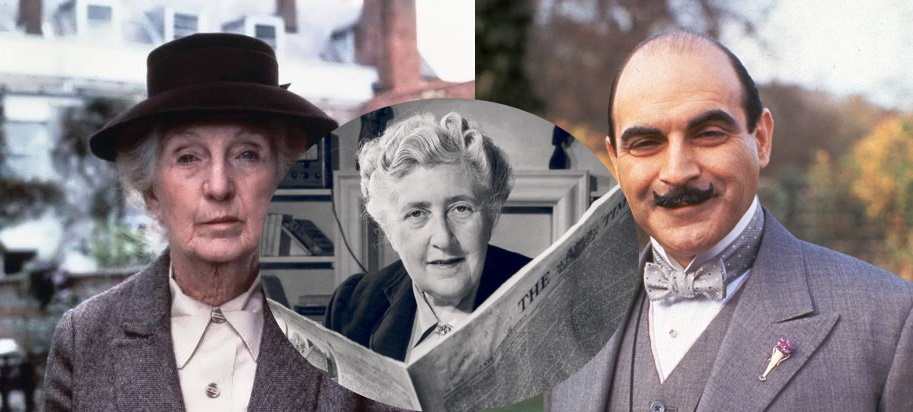
 “It is dangerous to believe people. I haven’t for years …”
“It is dangerous to believe people. I haven’t for years …”
There she sits: A white-haired lady dressed in tweeds, a pair of knitting needles in her lap, more interested in village gossip than in the goings-on of the world at large – and out of nothing, she utters sentences like that.
For more likely than not, another murder has been committed; and Miss Jane Marple, elderly spinster from the village of St. Mary Mead, just happens to find herself near the scene of the crime. And also more likely than not, while the police are still toddling around searching for clues she’ll find the solution – relying on her ever-unfailing “village parallels;” those seemingly innocuous incidents of village life making up the sum of Miss Marple’s knowledge of human nature, to which she routinely turns in unmasking even the cleverest killer. “Miss Marple is a white-haired old lady with a gentle, appealing manner – Miss Wetherby is a mixture of vinegar and gush. Of the two Miss Marple is the more dangerous,” already observes Vicar Clement, the narrator of Miss Marple’s very first adventure, 1930’s Murder at the Vicarage.
Originally airing on TV between 1984 and 1992, the BBC’s adaptations of Agatha Christie‘s twelve Miss Marple novels featured Joan Hickson in the title role; quickly establishing her as the quintessential Miss Marple even in the view of the creator of the grandmother (or rather, grand-aunt) of all village sleuths and “noticing kinds of persons,” Dame Agatha herself. (In fact, after seeing Hickson in a stage production of her Appointment With Death, as early as 1946 Christie had already sent her a note expressing the hope she would one day “play my dear Miss Marple.”) Prior realizations, partly involving rather high-octane casts, had seen as Miss Marple, inter alia, Angela Lansbury and Margaret Rutherford, but had been decidedly less faithful to Christie‘s books. While Lansbury holds her own fairly well when compared to the character’s literary original in 1980’s “Hollywood does Christie” version of The Mirror Crack’d (and that movie’s ageing actresses’ camp showdown featuring Elizabeth Taylor and Kim Novak is a delight to watch), the four movies starring Rutherford are only loosely based on Christie‘s books: Dame Margaret’s Miss Marple, although itself likewise a splendid performance, has about as much to do with Agatha Christie‘s demure and seemingly scatterbrained village sleuth as Big Ben does with the English countryside, and of the scripts, only Murder, She Said is at least loosely based on an actual Miss Marple mystery (4:50 From Paddington), whereas two of the others – Murder at the Gallop and Murder Most Foul – are, instead, inspired by Hercule Poirot stories (After the Funeral and Mrs. McGinty’s Dead, respectively), and Murder Ahoy is based on a completely independent screenplay.

Following the rule that ever since Sherlock Holmes and Inspector Lestrade every great private detective needs a policeman he can outwit, the creators of the BBC series inserted the character of Inspector Slack (David Horovitch) into almost all of the storylines – hardly in keeping with the literary originals, which are set over a period of more than 30 years and thus, exceed the career span of a policeman already advanced on his professional path at the time of his first encounter with Miss Marple; even if the BBC’s Slack is promoted from D.I. in Murder at the Vicarage and The Body in the Library to Superintendent in The Mirror Crack’d From Side to Side. Yet, Hickson‘s and Horovitch’s face-offs are a fun addition; and one is almost ready to pity Slack, who hardly ever gets a foot down vis-à-vis Miss Marple’s quick rejoinders and, in the words of her friend, retired Scotland Yard chief Sir Henry Clithering, “wonderful gift to state the obvious.” (During a conversation with Inspector Craddock in The Mirror Crack’d From Side to Side, Slack – whom Miss Marple herself, in the TV adaptation of Murder at the Vicarage, has already likened to a railway diesel engine, or in that story’s literary original to a shoe vendor intent on selling you patent leather boots while completely ignoring your request for brown calf leather instead – unaware that he is talking to one of Aunt Jane’s many nephews, rather unsubtly credits her with having “a mind like a meat cleaver.”)






The Body in the Library
 (novel 1942, BBC adaptation 1984)
(novel 1942, BBC adaptation 1984)
In response to a friend’s request, Christie makes a mysterious dead platinum blonde appear in the library of Miss Marple’s friends, St. Mary Mead’s squire Colonel Bantry and his wife Dolly. The horror! The scandal! – The BBC’s first adaptation starring Joan Hickson: Inspector Slack’s “good old policework” vs. Miss Marple’s “village parallels” … guess who carries the day?
Separate review here.
The Moving Finger
 (novel 1942, BBC adaptation 1985)
(novel 1942, BBC adaptation 1985)
One of the stories that, according to Christie‘s own opinion, have stood the test of time particularly well. – Lymston village is haunted by poison pen letters; and when people begin to die, there is no shortage of suspects. But Miss Marple, on a visit to a friend, sees through the killer’s cruel game.
A Murder Is Announced
 (novel 1950, BBC adaptation 1985)
(novel 1950, BBC adaptation 1985)
… and will take place on Friday, October 29, at 6:30 P.M.” But the person who ends up dead is the advertisement’s author himself. So who is he and what’s he got to do with the apparently intended victim, Miss Letitia Blacklog of Little Paddocks in Chipping Cleghorn?
Separate review here.
A Pocket Full of Rye
 (novel 1953, BBC adaptation 1985)
(novel 1953, BBC adaptation 1985)
“Sing a song of sixpence …” While the police are still in the dark and the press is beginning to speculate about black magic, Miss Marple finds clues to a string of murders in a children’s nursery rhyme. (And the murderer’s motive? “Oh, it was greed, of course. One knows that naturally …”)
Separate review here.
Murder at the Vicarage
 (novel 1930, BBC adaptation 1986)
(novel 1930, BBC adaptation 1986)
Christie‘s first Miss Marple mystery: Disagreeable Colonel Protheroe is murdered, and both his wife and her lover instantly confess – but actually, half the population of St. Mary Mead would have had a motive to kill him.
Separate review here.
Sleeping Murder
 (novel 1976, BBC adaptation 1987)
(novel 1976, BBC adaptation 1987)
The last published (though not last written) Miss Marple story. Here it is less the old lady herself than newly-weds Giles and Gwenda Reed who act as detectives, with Miss Marple’s help trying to get to the bottom of Gwenda’s unsettling visions relating to their new home, which she conceivably cannot have known previously, and a murder occurring there over 20 years earlier.
At Bertram’s Hotel
 (novel 1965; BBC adaptation 1987)
(novel 1965; BBC adaptation 1987)
Miss Marple deconstructs the all-too-respectable façade of a seemingly venerable London hotel, and the somewhat less respectable façade of a notorious lady of society.
Nemesis
 (novel 1971, BBC adaptation 1987)
(novel 1971, BBC adaptation 1987)
Actually the sequel to A Caribbean Mystery, though the earlier novel would only come to be adapted for the screen two years later (see below). – From his grave, rich old Mr. Rafiel sends Miss Marple on a bus tour of historic homes, to either clear his estranged son of a long-ago murder, or prove him guilty.
Separate review here.
4:50 From Paddington
 (novel 1957, BBC adaptation 1987; a/k/a What Mrs. McGillicuddy Saw!)
(novel 1957, BBC adaptation 1987; a/k/a What Mrs. McGillicuddy Saw!)
Miss Marple seeks the help of professional housekeeper Lucy Eyelesbarrow to investigate the murder of a woman, whom the village sleuth’s friend Mrs. McGillicuddy has seen being strangled from a passing train, and whose body must have disappeared somewhere on the grounds of the Crackenthorpe family estate Rutherford Hall. (In the original this, like A Murder Is Announced (above) and The Mirror Crack’d (below), is a story featuring Inspector Craddock, not Slack.)
Separate review here.
A Caribbean Mystery
 (novel 1965, BBC adaptation 1989)
(novel 1965, BBC adaptation 1989)
Transplanted to a, for her, most unusual West Indian setting, Miss Marple solves the murder of Major Palgrave, who was killed in an attempt to prevent him from foiling his murderer’s even more sinister intentions. – This episode also establishes the title of its sequel Nemesis (see above), although it is actually Miss Marple herself, not her new friend, rich old Mr. Rafiel, who names her thus.
They Do It With Mirrors
 (novel 1952, BBC adaptation 1991; a/k/a “Murder with Mirrors”)
(novel 1952, BBC adaptation 1991; a/k/a “Murder with Mirrors”)
Inspector Slack’s secret hobby provides a vital clue to the ungodly doings at the estate of Miss Marple’s old friend Carrie-Louise Serrocold, which Carrie-Louise’s third husband has transformed into a reformatory for young criminals.
The Mirror Crack’d From Side to Side
 (novel 1962, BBC adaptation 1992)
(novel 1962, BBC adaptation 1992)
The last entry in the BBC series (though not the last Miss Marple novel written and published), this mystery, which is based on real events involving Hollywood actress Jean Tierney and whose title is based on a line from Tennyson’s Lady of Shalott, revisits the grounds of Gossington Hall, erstwhile home to Miss Marple’s friends Colonel and Mrs. Bantry (where the BBC series had also opened with The Body in the Library). – After her husband’s death, Mrs. Bantry has sold the estate to ageing Hollywood star Marina Gregg. At a charity benefit, the charity’s secretary, who also happens to be a major fan of Miss Gregg’s, is found dead … and much points to Miss Gregg herself as the intended victim.




Production Credits /
Cast and Crew
Production Credits
- Studio: BBC (1984 – 1992)
- Directors: various
- Producers: Guy Slater & George Gallaccio
- Screenplays: various
- Based on novels by: Agatha Christie
Recurring Cast
- Joan Hickson: Miss Jane Marple
- David Horovitch: Detective Inspector (later Superintendent) Slack
- Ian Brimble: Detective Constable (later Seargant) Lake
- John Castle: Detective Inspector Craddock
- Gwen Watford: Dolly Bantry
- T.R. (Trevor) Bowen: Raymond West




Links
- The BBC “Miss Marple” series at the Internet Movie Database (IMDb):
- Agatha Christie’s Miss Marple at the British Film Institute’s Screenonline
- Themis-Athena’s reviews of individual episodes of the Agatha Christie’s Miss Marple TV series:
- Joan Hickson at the Internet Movie Database (IMDb)
- Joan Hickson at the Internet Broadway Database
- Joan Hickson’s obituary in The Independent
- Joan Hickson’s obituary in The New York Times
- Themis-Athena’s artist page for Joan Hickson
- Agatha Christie Ltd.
- Agatha Christie’s biography at the Kirjasto Authors’ Calendar
- Themis-Athena’s Agatha Christie author page
- Project: Little Grey Cells: St. Mary Mead & Elsewhere
- Themis-Athena’s review of the Agatha Christie’s Poirot TV series and some of its episodes:
- Themis-Athena’s review of the TV series adaptation of Partners in Crime
- Themis-Athena’s review of the movie adaptation of Witness for the Prosecution




13 thoughts on “MISS MARPLE”